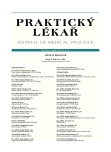-
Medical journals
- Career
Glucometers in hands of patients, general practitioners and in the intensive care units
Authors: B. Friedecký
Authors‘ workplace: Ředitel: Ing. Marek Budina ; Přednosta: prof. MUDr. Vladimír Palička. CSc. ; SEKK Pardubice ; Ústav klinické biochemie a diagnostiky LF UK a FN Hradec Králové
Published in: Prakt. Lék. 2011; 91(10): 581-584
Category: Reviews
Overview
Glucometers (from a number of manufacturers) have been used for the routine monitoring of blood glucose by diabetic patients and their physicians for a long time. This review deals with some of the problems with their use. There is a marked difference in self-monitoring results between patients being treated by antidiabetics and those patients whose diabetes is controlled by diet only. We compared the margin of error according to standard ISO 15197 with that actual margins of error achieved in practice. The most frequent sources of errors, namely human error, are also mentioned. Briefly we mention the most controversial use of glucometers, that of monitoring critically ill patients. Lack of human competency and control procedures are the main sources of errors. Education, control and proficiency testing are necessary tools for efficiency and safety in the use of glucometers.
Key words:
glucometers, self-monitoring, errors, education, proficiency testing.
Sources
1. American Diabetes Association. Standards of medical care in diabetes 2011. Diabetes Care 2011, 34, Suppl 1, S1-47.
2. Sacks, D.B., Arnold, M., Baktria, G.L. et al. Guidelines and recommendations for laboratory analysis in the diagnosis and management of diabetes mellitus. Clin. Chem. 2011, 57, 6, e1-e47.
3. Frenckmann, G., Baumstark, A., Jendrike, N. et al. Systém accuracy evaluation of 27 blood glucose monitoring systems according to DIN EN ISO 15197. Diabetes Technol. Ther. 2010, 12, p. 221-231).
4. Kristensen. G.B.B., Nerhus, K., Steie, S.B.M., Sandberg, S. Quality assurance of self-monitoring of blood glucose at the general practicioners office. Point Care 2006, 5(3), p. 100-104.
5. Kristensen, G.B.B., Nerhus, K., Thue, G., Sandberg, S. Results and feasibility of an external quality assessment scheme for self-monitoring of blood glucose. Clin. Chem. 2006, 52(7), p. 1311-1317.
6. Malone. B. Blood glucose meters. Is FDA ready to tighten up inaccuracy standards? Clinical Laboratory News 2010, 36(5), p. 1-3.
7. Van der Berghe. G., Wouters. P., Weehers. F, et al. Intensive inzulín therapy in critically ill patients. N. Engl. J. Med. 2001, 345, p. 1359-1367.
8. NICE-SUGAR Study Investigators. Intensive versus convential glucose control in critically ill patients. N. Engl. J. Med. 2009, 360, p. 1283-1297.
9. Karon, B.S., Boyd, J.C., Klee, G.G. Glucose meter performance criteria for tight glycemic control estimated by simulation modeling. Clin. Chem. 2010, 56, p. 1091-1097.
10. Sacks, D.B. Tight glucose control in critically ill patients: should glucose meters be used? Clin. Chem. 2009, 55, p. 1580-1583.
11. Kohn LT, Corrigan JM, Donaldson MS. To err is human: Building a safer health system. Washington: National Academy Press, 1999.
12. Meier, F.A. Point-of-care testing error. Sources, amplifiers, taxonomy, prevention strategies, and detection monitoring. Arch. Pathol. Lab. Med. 2005, 129, p. 1262-1267.
13. Kazmierczak, S.C. Point-of-care testing quality: some positives but also some negatives. Clin. Chem. 2011, 57(9), p. 1219-1220.
Labels
General practitioner for children and adolescents General practitioner for adults
Article was published inGeneral Practitioner

2011 Issue 10-
All articles in this issue
- Probiotics from the view of general practitioner – bacteria species used as a probiotics, their effect, safety and dosage
- Migrants and health care from the perspective of practice in the Czech Republic
- How can logotherapy help a doctor to accompany the dying
- Risk factors for the development of insulin resistance
- Sexuality of seniors.
- The using of FICA assessment in the elderly
- Empathy in the ethical attitude of doctors to their patients
- Primary hyperparathyreosis due to an ectopic parathyroid adenoma in the upper mediastinum as a cause of hypercalcaemia: case report
- Pathological gambling in seniors
-
Základy kognitivní, afektivní a sociální neurovědy
X. Kooperace - Recurrence of thromboembolic disease and the possibility of its prevention
- Glucometers in hands of patients, general practitioners and in the intensive care units
- General Practitioner
- Journal archive
- Current issue
- Online only
- About the journal
Most read in this issue- Probiotics from the view of general practitioner – bacteria species used as a probiotics, their effect, safety and dosage
- Primary hyperparathyreosis due to an ectopic parathyroid adenoma in the upper mediastinum as a cause of hypercalcaemia: case report
- Recurrence of thromboembolic disease and the possibility of its prevention
- Sexuality of seniors.
Login#ADS_BOTTOM_SCRIPTS#Forgotten passwordEnter the email address that you registered with. We will send you instructions on how to set a new password.
- Career

